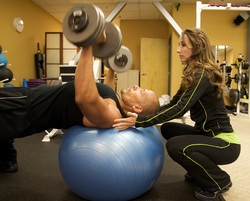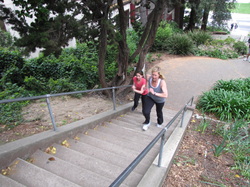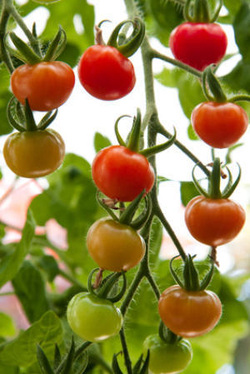|
Looking for a way to increase self-esteem, reduce inflammation in your body, lower your Body Mass index, and increase your overall cardiovascular health? Volunteer! Spending just one week giving back to your community can increase your life, by helping you improve your cardiovascular health. For more information, check out the study below conducted by University of British Columbia researchers.
http://www.sciencedaily.com/releases/2013/02/130225162229.htm
0 Comments
Despite significant advances in the treatment of cardiovascular
(heart) disease, it is still the leading cause of death in the United States. Did you know that Diabetes, especially Type 2 Diabetes is a major risk factor for cardiovascular disease? Death from heart disease is 2-4 times more likely in adults with diabetes than their counterparts without diabetes. There are several known factors that can increase your risk of developing and potentially dying from heart disease. Some of those include being male, obesity(especially weight in the abdomen), using any form of tobacco, and having higher total and bad LDL (“bad”) cholesterol levels, and high blood pressure. These are all considered “classic” risk factors and are commonly monitored by healthcare professionals. There are other biological markers that can be watched to get a larger picture of what is really going on in your body with your heart and blood vessels. One must remember that these additional markers and tests are not as thoroughly researched as the above mentioned markers, but they may provide additional information that may prove useful in certain situations. This is particularly true when “classic” markers give mixed signals. What exactly is a biological marker? Biomarkers are considered an “indicator of normal body processes, disease-related processes, or response to a therapeutic intervention.” Diabetes Self-management May/June 2013. The relationship of any such measurement to health or disease is established through scientific studies involving both healthy and sick individuals. This implies that as we continue to do research any one of the following biomarkers may gain or wane in its importance. Experts are still trying to determine if early detection and treatment of cardiovascular disease based on cardiovascular biomarkers is useful in delaying or preventing the onset of cardiovascular disease. One of the most commonly used cardiovascular biomarkers is High Sensitivity C-reactive protein. This marker is an indicator of inflammation and may indicate the presence of atherosclerosis, a fatty buildup of the arteries. Out of all of the currently used biomarkers, High Sensitivity C-reactive protein has the greatest connection between elevated levels of the protein and heart disease and future cardiac events (Heart attacks and strokes). It is commonly found that people with diabetes have elevated levels of this protein. B-type Natriuretic Peptide. This biomarker is most frequently used to help detect and determine the severity of congestive heart failure. B-type natriuretic peptides are released into the blood in order to help the heart which enlarges as a response to not being able to adequately pump blood through the body. Enlargement of the heart is common with heart failure. A tendency towards elevated levels of this peptide would correspond with the risk of heart failure. Some studies have suggested that decreases in this biomarker can be beneficial. Adiponectin is hormone that aids in controlling blood glucose levels and the breakdown of fats in the body. Though various studies have been done scientists are still not exactly sure why reduced levels of Adiponectin are associated with various “classic” risk factors for cardiovascular disease such as obesity, Type 2 diabetes, and atherosclerosis. It is good to remember that there are very few cardiovascular biomarkers that are being used at the present time and not all of these will be used by every healthcare professional. However, since these tests may yield greater information as to your cardiovascular risk before other “classic” risk factors are present, especially if you have diabetes, it doesn’t hurt to ask your health care provider to do some or all of these tests. If you fall into a high risk group for cardiovascular disease, try some of the following tips to help prevent cardiovascular disease. 1. Ask questions. Education is a very powerful tool to have on your side. Especially if you have a family history of cardiovascular disease or you have diabetes. 2. Understand Biomarkers. By understanding which biomarker tests may be most beneficial to your particular situation, you will know exactly what to ask your doctor for. 3. Gather Information. Check out www.labtestsonline.org 4. Know the “classic” risk factors and how they affect you. 5. Develop habits for heart healthy eating, including portion control for weight and blood glucose control. 6. Participate in regular physical activity. Please contact your health care provider before beginning an exercise program. 7. Minimize risky behaviors. Quit smoking, chewing, or any other form of tobacco use. “New Poor”~ Those who were previously middle class but because of
the economic downturn they are now living at or below the poverty level. More and more people are learning to live with less. People are looking for places where they can save money in their budgets, places where cutting corners will allow them to attempt to continue the lifestyles they were previously accustomed. One of the first and easiest places for most people to trim back the fat is with the groceries they purchase, the foods that they consume. There are after all a multitude of options, varieties, brands, and choices. Where does one even begin? We know we want to feed ourselves and our families the best possible foods available, but when presented with the option to purchase sweetened apple sauce for $.50 a can, conventional apples for $.99 a pound, and organic apples for $2.99 a pound, the choice is easy. The cheapest choice usually isn’t the best for our bodies or our families, but we also don’t need to spend absorbent amounts of money to eat healthy either. The first place we can start is by creating a budget. Eating on a budget means that we will have to make some behavioral changes. If you are one of those people who regularly stops for fast food, grabs pre-made options at the grocery store, or eats out frequently, you are probably eating low quality foods and you are spending a fortune as all of these options are expensive! Think for a moment, how much do you spend on bottles of water or cups of coffee per week? Developing a budget can help you become both healthier and wealthier. Changing any habit takes time, patience, and support. Set up realistic goals for you and your family. You will find that budgeting will become easier with time. Below you will find 12 tips and tactics to help you eat well on a budget: 1.Know yourself. Are you a meat and potatoes kind of person or do you prefer to live a mostly vegetarian lifestyle? It doesn’t make much sense to buy a bunch of greens that are on sale at the farmer’s market when your whole life you have hated greens. Try making a list of all of your and our family’s favorite foods. Put emphasis on healthy options, such as fruits, veggies, nuts, eggs, seeds, etc. Once we have this list, we need to look at what kind of cook we are and what our time restraints are. Are you a single father of 4 who has a max of 20 minutes nightly to cook or are you a grazer who does better with small snacks or meals throughout the day versus 3 set big meals? Are you an emotional eater? Do you find that you tend towards certain foods at certain times of the month? Knowing what your time constraints are, your preferred style of eating, and any emotional triggers will help you to stick to your budget as you will be able to account for those things. There are however some guidelines or basic dietary recommendations for everyone. Everyone should aim for a balanced diet that is eaten on a regular schedule. Maintaining blood sugar levels throughout the day is not only better for our bodies, but will also help keep us on track and we won’t reach for those cheap convenience foods that are both unhealthy and expensive over time. Meals should contain a variety of foods including greens, vegetables, lean proteins, legumes, and dairy. Avoid artificial sweeteners, sugars, and too many grains or grain products. Additionally, aim for 80oz of water daily. 2.Familiarize yourself with your resources. If you are truly struggling in the financial department there are many different programs designed to help you obtain food at little or no cost. Did you know that in most states you can dial 2-1-1 to get assistance on how to navigate all the resources and agencies that currently offer help or assistance? If you have access to the internet at home or via a public library check out www.feedingamerica.org which can help you locate free food assistance programs in your area. For tips from an incredibly resourceful husband and wife team visit www.moneysmartfamily.com. The SNAP program www.fns.usda.gov/snap commonly referred to as food stamps helps millions of people annually to purchase necessary food items. 3.Take inventory. What kinds of foods do you already have in your house? Check the pantry, freezer, refrigerator, and kitchen cabinets. People are often surprised by just how much food they actually have in their homes at any one point in time. With a little creative meal planning some awesome meals can be made. Remember you can always make substitutions in recipes to use what you already have at home. Make sure you discard anything that is expired or appears spoiled. Typically if you are unsure, it is better to toss it than to take the chance of getting you or one of your family members sick. 4.Have a plan of action. Your action plan should include your money–saving goals, menu plan, and shopping lists. In order for your menu planning to be successful, it is best to take baby steps. Start by planning the most challenging meals for you or your family. Do you often feel rushed to get healthy dinners on the table? Start by planning out some dinners for your family. Try using a slow cooker that you can toss all the ingredients into in the morning and come home to dinner ready, or following some of the recipes by someone like Rachel Ray www.foodnetwork.com/30-minute-meals/index.html . Gradually, you will be able to plan out your whole month. Remember just because you plan to have something one day, doesn’t mean you have to have it,. You have the necessary ingredients on hand to make it or you can always go with something else that inspires you at that moment in time. As for making your grocery list, this is an incredibly powerful tool, not only to help you save money but to guarantee you are eating healthy as well. Sticking to a grocery list can help keep you from buying those convenience foods and any other unnecessary items. Try organizing your grocery list by sections of the store. 5.Use coupons. Using coupons can save families as much as $1,000 per year on groceries. Coupons are widely available in newspapers, online, magazines and are often attached to recipes. Clip and sort coupons according to the sections of your shopping list. Be sure to read the small print on coupons in case there are any special instructions. There are some cautions to take when using coupons. Coupons are often printed for items that lack nutrition like Capri Suns and Handi-snacks. Don’t get sucked into buying these products because you have a coupon for them. Additionally, always check the store name brand or other generic brand for its price. Often times these items will still be cheaper than the name brand with the coupon. Remember we want to save both money and put the highest quality foods on our tables. 6.Shop savvy. For time, labor and expense purposes, it is typically recommended to do all your shopping at one grocery store. It is the reasons like Target and Walmart now have full grocery sections. However, you should remember that great deals on food and other household items can be found at dollar stores and pharmacies. Check out the weekly circulars in your area and pay attentions to the sales. The local Mexican market may be having a huge produce sale and while it isn’t the local Whole Foods or Safeway where you normally shop, going there this time may save you a significant amount of money on the same exact products. When buying groceries shop mid-week and on a full stomach. When possible, shop without your children so that you can maintain your focus. Shopping in the morning may yield markdowns in the produce and meat departments as well as “end of day” sale items from the previous day in the deli. Always remember that products at eye level tend to be more expensive, look high and low on the shelves for lower prices. Generic and store brand items can be significantly less expensive than, and similar in quality to, name brand items. Take time to check labels for hidden sugars and trans fats. To limit your intake of trans fats avoid any products with partially hydrogenated oil in its ingredients list. To avoid impulse buying, stick to only what is on your grocery list. If there is something that is on an incredible sale, such as blueberries, and you have space in your freezer, seize the opportunity even though they weren’t on your list, but these exceptions will be few and far between. Buying things in bulk can save you a lot of money, but only if you have the space in your freezer to properly store the excess that you won’t be eating immediately. Remember that most deli departments will slice a large block of cheese or meat for free, allowing you to save money by not purchasing the pre-sliced meats and cheeses. A tip to remember is to avoid buying most processed foods, but avoiding most anything sold in a box. If you take a look at things sold in boxes other than possibly organic broths, these items tend to have low nutritional quality and are expensive in comparison to their fresh or even canned counterparts. Avoid specialty foods unless absolutely necessary and shop the perimeter of the store. A great place to purchase your fruits and veggies are at your local farmer’s market. Vendors typically drop prices just before closing. You may also try to negotiate with a local farmer for whatever produce is in season as he may have a surplus that he needs to get rid of. 7. Prepare your own food. Learning to cook and prepare healthy meals with simple ingredients can change your life. Buy finding a couple recipes you love and are easy to make and then keeping these ingredients on hand, meals will become simplified. Just after you go to the grocery store, take the time to do your own chopping, dividing, freezing, mixing, and sorting of your foods to prepare for quick meals on busy days. If one partner does most of the cooking the other one can do the prepping. Cook in bulk and freeze half of what you make, for example with soups and stews. This makes dinner or lunch incredibly easy, just de-frost heat and serve on those busy nights. If freezing meals isn’t an option, make sure to cook enough for a couple meals. You will save yourself time by having the leftovers for lunch or dinner the next day. Stir frys make quick easy meals as does throwing everything in a crock pot before you leave for work in the morning. The food slow cooks all day, and is ready when you return home. When you make pasta sauces, meat loafs, and other items, add extra veggies to them, which will help stretch them for a minimal cost and make them more nutritious. 8.Use the plate method. Using the plate method is super easy to do and to understand. Using this method simply means that you should have the following on your plate. ½ of your plate should be covered with veggies, preferably a minimum of two different vegetable, ¼ should be your lean protein equal to 20-25g of protein, and the remaining ¼ can be a whole grain carbohydrate source. I however recommend that you omit the grain at dinner. Limit it to breakfast or dinner. Try seasoning your foods with various herbs and spices instead of adding a bunch of sauces or sweeteners. 9. Strive for a more plant based diet. I am a huge fan of animal proteins, not only do I feel better, but I get sick less often, and have more energy. Meat, fish, chicken and dairy can be very costly. Especially when you are purchasing organic meats, dairy, eggs, and fish. Due to the amount of hormones that are being pumped into animals and the foods that are being fed to them, it really is in your best interest to purchase only organic meats and animal products. In doing this, offset the costs by working in more beans, legumes, nuts, hemp, seeds and other vegetables. Organic eggs are a great addition to add protein to otherwise vegetable based dishes and meals. You will save enough money to afford the organic meats from time to time. You will also guarantee a greater variety of foods are introduced into your diet. 10.Have snacks available. Low calorie and affordable foods are easy to fit into your life. Chop up fruits and veggies that are in season, divide raw nuts and seeds into individual servings, keep cottage cheese and Greek yogurt on hand, and non-gmo edamame in the freezer which can quickly be boiled up. You will be less likely to reach for the unhealthy quick and easy foods if you keep these healthy snacks around and your blood sugar levels stable. 11. Grow your own food. Home gardening can be very enjoyable and done just about anywhere as long as you have appropriate access to direct sunlight. It is the only true way to guaranteeing the quality and freshness of the food you are putting on your table. One tomato plant seedling can be purchased for a couple dollars, seeds are even cheaper, soil, and a pot and you are good to get started. With an initial investment of under $10 you can grow a plant that will easily save you over $100. You will have enough tomatoes to make pasta sauce, add to salads, burgers, and anything else you want them for. If growing vegetables seems overwhelming for right now, grow your own herbs, you can save your family a great deal of money and add some awesome flavors to your foods. 12. Allow for the unexpected. Attempt to have almost ready foods available in the freezer or refrigerator for days when you don’t have your normal amount of time to prepare a meal. Many healthy meals can be prepared quickly; for example you can cook up a frozen turkey burger and serve it with fresh lettuce and tomatoes. If you pre-cut your veggies ahead of time, you will shorten the time spent in the kitchen even more. If you really have no time to make food at home, remember that is usually cheaper and healthier in most parts of the country to grab food from the deli at your grocery store than to go to a restaurant. Life is unpredictable and no matter how perfectly we plan out our meals or how we are going to save money, sometimes things are out of our control. Have patience with yourself and life and give yourself credit for all the positive changes you have made thus far. This is a lifestyle change, it isn’t going to happen overnight and no one is perfect, there will be a moment when you are on that road trip and you eat something outside of your budget or that is less than healthy, but as long as our overall pattern is one that is healthy, you will see that you wallet benefits as well as your overall health.  Did you know that stress combined with a sedentary jobs increases your risk of cardiovascular and metabolic disorders? Would you believe that brief moments of guided meditation and yoga at your desk can help reduce your stress?? As little as 15 minutes to be exact. A recent small study including just 20 people who were taken through each of the following; a guided meditation, yoga, and allowed to continue working without interruption. Each intervention lasted 15 minutes and there was a day between each of the interventions. Different stress markers were tested at the baseline, during the 15 minute interventions, and 15 minutes after. Different measures were recorded such as perceived stress, blood pressure, respiration rate, heart rate, and heart rate variability. Analysis of the data showed both yoga and meditation reduced perceived stress (the mental aspect) plus the effect continued after the post-intervention period. The markers for physical stress tended to return to the baseline levels with the exception of respiratory rates following chair yoga. While the study was relatively small, its results conclude that there is no harm in implementing a basic 15 minute chair routine at least once a day, especially if you are in a sedentary career. More studies need to be conducted but one can assume the data suggests that the level of productivity, improved employee health, job performance, job satisfaction, and absenteeism could be positively affected by the implementation of workplace yoga and meditaiton. The following link will provide you with a variety of chair yoga poses you can try. http://yoga.about.com/od/yogasequences/tp/Chair-Yoga-Poses.htm  Did you buy into the notion that doing Wii fit programs or other active video games would help you or your family members get in shape? Millions of people out there believed the very same thing, but a recent study suggests different. In March, 2012 the medical journal Pediatrics release the results of a study that suggests the increased movement associated with active games like the Wii fit and other games bears no significant difference in overall activity levels of users. The 13 week study included 78 kids, 51% of them were boy from varying ethinic backgrounds. The kids were divided into two groups, one that played active games and other played normal sedentary games that didn't require mvement of participants. After reviewing the play logs of the children and the collected data from their accelerometers which measured their exertion, scientists and doctors were able to conclude that there was no significant difference between the two groups of children. The major difference noticed was, children who were in the active group and under observation played more vigorously than those who were not under observation. It was believed that once the children were no longer under observation, their activity levels fell below those of the children in the sedentary video games group. In conclusion it is safe to say that active video games do not provide a public health benefit to you or your children. However, if you are going to play games, or let your children play, why not make it a game that forces them to get up and move around a little. When in doubt, the best option is and always will be, use of the imagination, running around, in the natural light and fresh air of the outdoors. Pack up the controllers, pick up a ball, or bike and enjoy!  Is training on a stability ball beneficial to your workout routine? No evidence to date proves for or against that but recent studies show that sedentary adults may benefit from using a stability ball at work and to do basic exercises. Read the following study for more information. http://www.ideafit.com/fitness-library/stability-ball-training-sedentary-men-and-women-0  Only have 20 minutes of energy you can muster up? Is your lunch break the only time you can carve out of your day to exercise? You may be in luck as recent studies have been pointing to shorter more intense workouts and their HUGE benefits. An 18 year study was recently finished in Copenhagen, Denmark that wanted to see the relationship between exercise intensity and/or duration and mortality. They pooled together 5,106 people, both men and women, ages 21-90 to take part in the heart study. Participants were asked to rate their daily activity as slow, average, or fast and whether their activity last less than 30 minutes, 30 minutes to one hour, or more than an hour. All of the participants used cycling as their means of exercise. During the study, 708 men and 464 women died, with 108 of the men and 38 of the women dying from cardiovascular disease. From this information the researchers were able to deduct that those who particpated in shorter more intense exercise tended to live longer than those who participated in slower longer exercise bouts. In fact, "men with fast intensity cycling survived 5.3 years longer, and men with average intensity 2.9 years longer, than the lower-intensity, longer duration cyclists." "For women the figures were 3.9 and 2.2 years respectively." After reading this, you are now inspired to create more intense workouts but don't know where to start or don't want to get hurt. Follow these guidelines to make sure that you don't injure yourself on your journey to increasing your life expectancy! Be aware and familiar with your own body. Make sure you are able to communicate with your trainer, friends, or yourself when something feels too intense, or out of the ordinary. The goal isn't to go until you drop dead. Make sure you know variations and modifications to the different exercises you want to do. Being educated and having the ability to modify an exercise ensures you don't get hurt and you can go at a pace appropriate for you and where you are in your greater scope of things. Additionally, make sure you are working with a trainer who can modify just about any exercise for you, to accommodate your needs and goals. If they can't do that for you, look for a new trainer. Keep your workouts short. Remember the more intense you train, the shorter the workout should be. By pacing yourself and resting, you can set yourself up for injuries. Educate yourself on the major muscles of the body and what they do. This will help you maintain balance. For example, pair a push up with a row, or in easy to understand terms, a chest exercise with a back exercise. By using opposing muscle groups you will allow your muscles to recover between sets allowing you to keep up the intensity. So go out and sweat, and remember, you don't need an hour to get a good workout in, you just need the determination to work hard and to do something that is great for your body and life in so many ways!  Fast food Vs Home Cooked food, which is cheaper/more economical? Many people will guess fast food with all of the $1 menu items out on the market these days. The truth is, home cooked meals are actually cheaper per serving than even $1 items. Since the US is incredibly money driven and we now know it isn't economical to eat fast food, what are some other reasons why people stop for fast food and how can we break the cycle? When was the last time you stopped to plan a meal and cooked it. A meal with more to it than boil water, add noodles, drain, add sauce? People don't take the time to cook anymore. Family and individuals are incredibly out of practice. Cooking at home is something our mothers did in the 50's, now we all work a million hours a week and don't have time to cook. The reality is, cooking doesn't have to be as scary or hard as it seems, two other reasons why people don't cook. All it takes is a little planning and education and you can be on your way to making amazing meals for you and your loved ones that are more affordable than the local drive thru. First things first, get in the kitchen and experiment. Try new recipes, blend spices that you know you like, and give it a whirl. Practice makes perfect. Sure you will probably have a dud or two from time to time, (I just had one today) but you will undoubtedly come across quite a few more than you love or that become staples around your house. If you are still feeling shy in the kitchen, hire some help. There are plenty of cooking classes, local chefs, cooking groups and resources to help you feel more comfortable in the kitchen. Look for classes that interest you, such as beef prep classes, or vegetarian asian dishes. Depending on where you live, there are classes every single week. Organization will be helpful as well. Personally, I try to cook or prep a few dishes on Sundays. It is the only day when I don't train a single client. If I plan things out correctly, I can make two or three dishes in a 2-3 hour time frame that will last us for at least the first half of the week. Knowing that I have food in the fridge ready to be heated, makes it much easier for me to resist eating out or eating something I shouldn't when I get home at 9:30pm after 10 hours with clients. Being prepared and ready won't only help you save some money, it make save your life. Whatever your reason for not cooking at home, make a resolution to cut back on eating out, not just fast food, but all eating out and take control of your life and your future through the food you put in your body. Remember food is your body's fuel, and if you fill the take with highly proccessed fatty foods, you can't expect optimum performance. Below are some resources to help you break the slow food cycle. www.alisonroessler.com www.myrecipes.com www.cookinglight.com www.slowfoodusa.org  Ok, so maybe they aren't proven to save lives completely by themselves, but studies have shown that they are SUPER HIGH in antioxidants! How often have you wondered if Organic really makes a difference? How often have you questioned if the nutritional benefits really outweighed the dent buying organic creates in your wallet. It is true that you can often get with not buying all your fruits and veggies organic, but recent science shows that you should buy your tomatoes organic, if for nothing else, to reap the cancer fighting benefits of the antioxidants in tomatoes. Follow the link below for more information on the study performed by the University of Barcelona. http://www.sciencedaily.com/releases/2012/07/120703120630.htm Excess Weight in Pregnant Women Can Have Negative Health Implications for Offspring in Adulthood5/15/2012 Thinking about getting pregnant or are you pregnant now? How you treat your body before and during pregnancy can leave its mark on your future offspring. Children are much more likely to have health issues not limited to obesity as they age and mature all the way into adulthood based on the mother's eating habits and exercise routine. Taking care of your body now and during a pregnancy may be the one most important thing you can do to ensure the quality of your child's life. Please read further for more info:
http://www.sciencedaily.com/releases/2012/05/120513144531.htm |
Author# 1 Trainer in Oakland and the East Bay, sharing health, fitness, and lifestyle information. Archives
April 2023
Categories
All
|
 RSS Feed
RSS Feed